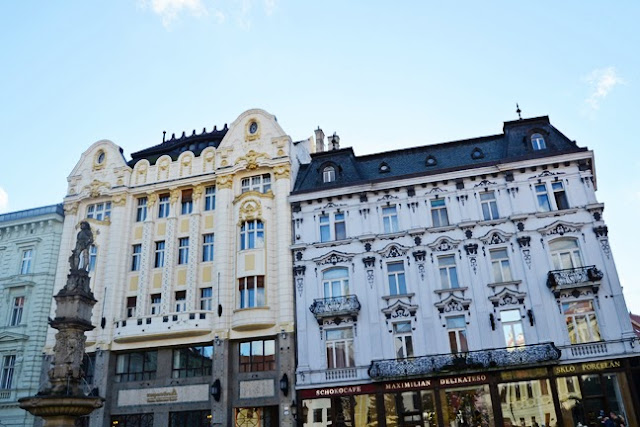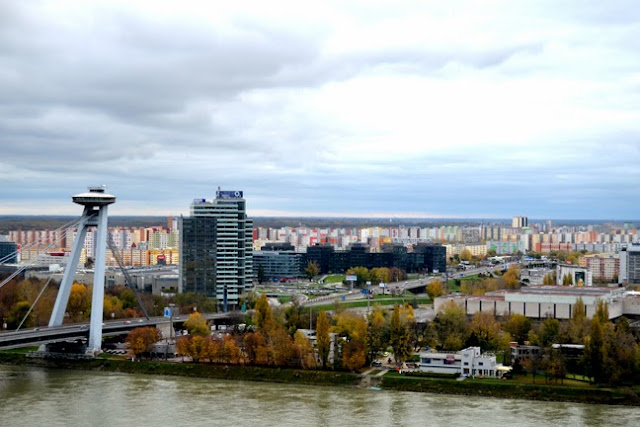After our morning adventures in Vienna we took advantage of our close proximity (just 30 miles) to another country and headed to Bratislava, Slovakia.
Never in a MILLION years did I ever think I'd be visiting this country. All growing up you heard "Slovakia" and you immediately thought "Scary". But keep reading and you'll come to see that it's a very different place than it once was.
Bratislava's priceless location - on the Danube (and the tourist circuit) smack-dab between Vienna and Budapest - makes it a very worthwhile destination. Long a drab lesson in the failings of the communist system, the city is turning things around. Just a decade ago Bratislava's city center was grim, deserted, and dangerous - a place where only thieves and fools dared to tread. Today it's downright charming, bursting with colorfully restored facades, lively outdoor cafes, swanky boutiques, in-love-with-life locals, and (on sunny days) an almost Mediterranean ambiance. The rejuvenation doesn't end in the old town. The ramshackle quarter to the east is gradually being flattened and redeveloped into a new forest of skyscrapers. Bratislava is working tother with its neighbor Vienna to forge a new twin-city relationship for trade and commerce, bridging the former Eastern Europe and the former Western Europe. Before our eyes Bratislava is becoming the quintessential post-communist Central European city - showing us what can happen when government and business leaders make a concerted effort to jump-start a failing city. And yet, it's still a city in transition, with sometimes striking contrasts. Tucked between the quaint old town and super-modern Euro-commerce zones, large pockets of post-communist decrepitude remain. There's a reason why movie makers wanting to show the stereotypically gloomy "communist Eastern Europe" decide to film here... But all of the changes are positively inspiring. While they still have a long way to go, the Slovaks have made the city well worth a quick visit to get a glimpse of a country in transition.We banked on a few hours to get the gist of Bratislava and were happy with the amazing views we got as we delved deeper into the city center - both the castle and the iconic UFO in one shot!




Underneath the gate we found the "kilometer zero" plaque in the ground, marking the point from which distances in Slovakia are measured.
Above the chocolate shop's entrance, a cannonball is embedded in the wall, commemorating Napoleon's two sieges of Bratislava, which together caused massive devastation - even worse than the city suffered during WWII. Apparently there are cannonballs all over town - somber reminders of one of Bratislava's darkest times.


This is the bustling centerpiece of Old World Bratislava. Cute little kiosks sell local handicrafts and knickknacks Easter through October and similar stands fill the square from mid-November until December 23rd when the Christmas market here is a big draw. Juuuuust barely missed the Christmas markets dangit! Virtually every building around this square dates from a different architectural period.
Peering over one of the benches in the Main Square is a cartoonish statue of a Napoleonic officer. With bare feet and a hat pulled over his eyes, it's hardly a flattering portrait - the Slovaks' revenge for the difficulties they faces at Napoleon's hands.

At the top of the Main Square is the impressive Old Town Hall marked by a bold yellow tower. We found another cannonball embedded in the facade. They just paint right around them!

This pink mansion is Primate's Palace.
Primate's Palace is a neoclassical palace, built from 1778 to 1781 for Archbishop József Batthyány, after the design of architect Melchior Hefele. In 1805, the Palace's Hall of Mirrors saw the signing of the fourth Peace of Pressburg, ending the War of the Third Coalition. Today, it serves as the seat of Mayor of Bratislava.
Back into the Main Square, we saw this charming vehicle - looks fun!

The Slovak National Theater is the second oldest Slovak professional theatre. It has three ensembles: drama, opera, and ballet. It was founded in 1920 after the creation of Czechoslovakia and became a state-run company in 1945. The Slovak National Theatre has represented Slovak culture on its numerous tours abroad.

Another pretty street lamp and the fortified US Embassy. Naturally surrounded by guards and gates galore.

The German Embassy.
At the end of the street we turned left to cross New Bridge, the communist's pride and joy.
As with most Soviet-era landmarks in former communist countries, locals aren't crazy about this structure - not only for the questionable starship Enterprise design, but also because of the oppressive regime it represented. However, the restaurant and observation deck up top has been renovated into a posh eatery called (appropriately enough) UFO.


We got a spectacular view of Bratislava Castle from the other side of the river.

Fall is still hanging on!
We walked back across the bridge towards St. Martin's Cathedral.


Multicolored houses.


Part of the old 15th-century city wall.
This historic church isn't looking too sharp these days and the highway thundering a few feet in front of its door doesn't help matters.
If the freeway were any closer the off-ramp would go through the nave! (And a picture of me in front of the castle that we went to later in the day.)

Sad as it is now, the cathedral has been party to some pretty important history. While Buda and Pest were occupied by Ottomans for a century and a half, Bratislava was the capital of Hungary. Nineteen Hungarian kings and queens were crowned in this church - more than have been crowned anywhere in Hungary! In fact, the last Hungarian coronation was not in Budapest, but in Bratislava. A replica of the Hungarian crown still tops the steeple. We would have liked to go inside to see such an important church, but alas, it was Sunday and not open to tourists.
Sometimes you just gotta let them roll around...
Walking around Bratislava.

We finally figured out the right address and quickly drove by Grassalkovich Palace (the residence of the president of Slovakia) on our way up to the castle.

The imposing fortress, nicknamed the "upside-down table"is the city's most prominent landmark. There surely has been a castle on this spot for centuries as is evident from the old foundations in front of the castle.
The oldest surviving chunk of the castle is the 13th-century Romanesque watchtower (the one slightly taller than the other three). When Habsburg Empress Maria Theresa took a liking to Bratislava in the 18th century she transformed the castle from a military fortress to a royal residence suitable for holding court. She added a summer riding school, an enclosed winter riding school out back, and lots more. Maria Theresa's favorite daughter, Maria Christina, lived here with her husband Albert (Albertina!) when they were newlyweds. I wouldn't have minded living in a place this big when we were first married...
The castle burned to the ground in an 1811 fire and it was left as a ruin for 150 years before being reconstructed in 1953. Unfortunately the communist rebuild was drab and uninviting; the inner courtyard feels like a prison exercise yard:


And then the city ends and it's green as far as the eyes can see.
Such an interesting looking place! I've never seen anything like it!
Then it started raining and getting cold. Luckily we were done with all we wanted to see and do so we loaded back into the car for the short 45 minute drive back to our apartment in Vienna.
We ordered pizza to go from the restaurant below and to the left of our abode.
The next morning we planned to go to Schönbrunn Palace AND Belvedere Palace, but it was raining cats & dogs and the kids were so done. These pictures sum up our 5 hour drive home to a "T".



















































Loving the photos .. those statues are so fun!! Poor Fox!!
ReplyDeleteWhat an awesome city! Gerrit's great-grandparents immigrated from Slovakia and I know his mom really wants to go. I think they were from further out in the country, though.
ReplyDeleteI was pleasantly surprised by Bratislava. It didn't hurt that the weather cooperated either
ReplyDeleteWow I love the gates going into the castle! And the Primate's Palace is a dream! Wish you guys could have gone to the UFO restaurant! I'm sure Fox Mulder would have loved that ;)
ReplyDeleteAnd those pictures of Fox crying in the car! Yikes! No kids for us for a VERY long time!!
I love reading about your adventures! My husband and I are stationed in Papa Hungary, and have done most of the trips you post about. It's funny because I'll skip over to your blog to see if I've missed any history. You keep me on my toes. I'm happy the weather cooperated with you for the Bratislava leg of your trip. Last weekend my family and I headed to Brasov Romania to visit Bran Castle. The castle was interesting but the city and scenery was over the top. If you have the chance definately recommend!! Here's to continuing adventures in Europe!!
ReplyDeleteSo Cool. My brother just got home from his mission 3 months ago from serving in that exact town. He LOVED. it.
ReplyDeleteAwesome! Looks beautiful!! :)
ReplyDeleteThose last two photos are HILARIOUS! (Well, if you're at a stop ;) ) "And yes, Fox, that is why it's called a *CHEST* clip. It goes at your chest, so you can't fly out if we're in an accident!" LOL. :-p
It was lovely to hear (read) all of those nice things about my country from you! I love how you see the positive in everything and - i'm ashamed to say, that i've even learned a lot from your post about my own country :)
ReplyDeleteIf you ever get a chance to visit the Tatra mountin, you should go! It's a natural border between Slovakia and Poland, it's beautiful and that's where I come from :) xxx